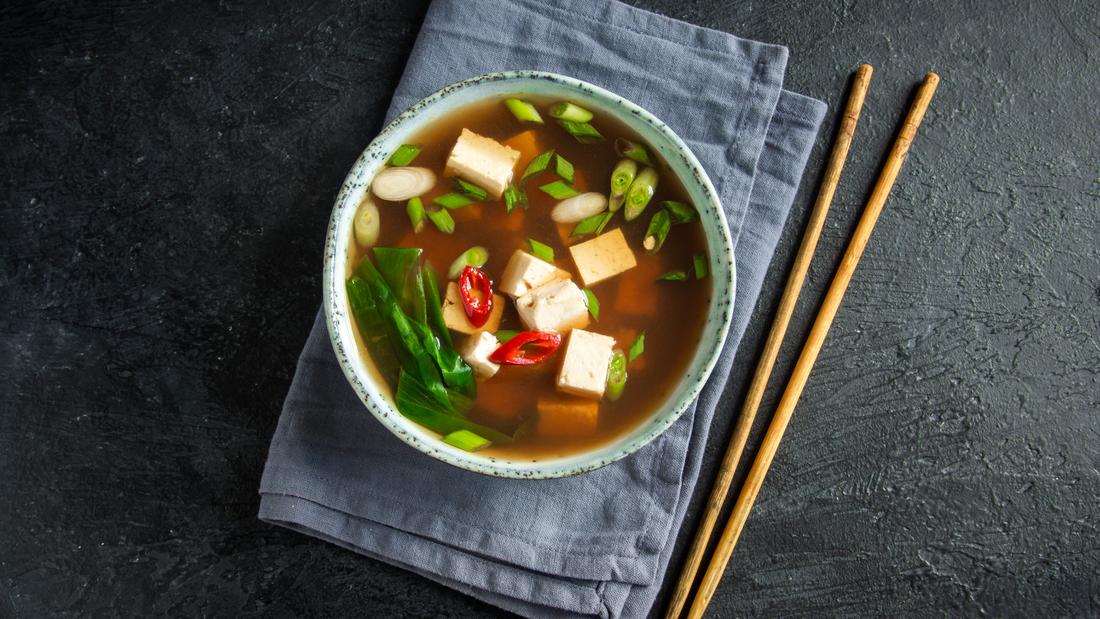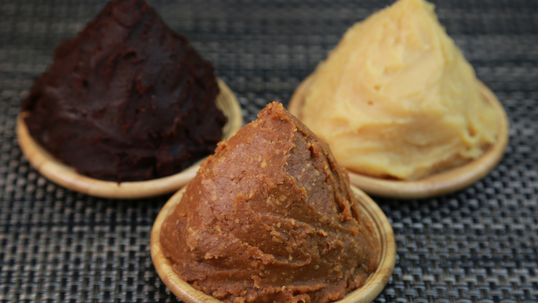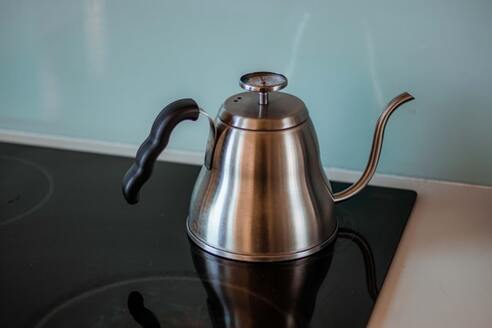|
What is miso? MIso - you get miso soup with your sushi platter, but do you know what it is? Miso is a fermented bean paste. Miso's origin Depending on the source of information, miso either originated in ancient China and then introduced to Japan over 1,000 years ago by Buddhist priests or it originated in Japan in the Yayoi period, 300 BCE to 300 CE. Grain and fish misos had been manufactured in Japan since the Jōmon period, 14,000–300 BC. It’s possible that citizens of both countries figured out that you can ferment grains or legumes with salt to preserve them. Curing food with salt to preserve it crosses cultures. To make miso, soybeans are fermented for anywhere between three months to three years with a mould called koji. Koji can grow on cooked soybeans or grains. Steamed white rice is the most common way to grow koji. Koji breaks down the structure of the soybeans into amino acids, simple sugars, and fatty acids. At its most basic, the miso soup you get with your lunch combo is miso paste mixed with hot water. Sometimes the soup comes with tofu and green onions. The flavour of miso depends on the ingredients used, fermentation time, and koji ratio to soybeans. Miso adds a salty, umami flavour to dishes. If you ever stood in front of jars of miso at the grocery store and wondered about the colour difference, here’s the answer: Generally, the darker the miso, the more intense and salty the miso will taste. Darker miso has been fermented longer and has a more intense flavour. Lighter miso has a short fermentation and is sweeter. Nutritional profile of misoOn average, one tablespoon of miso has
Fermented foods and healthIn general, fermented foods are beneficial for the gut. A healthy gut contributes to a healthy brain, a healthy immune system and good health overall. Fermented foods naturally contain probiotic bacteria- unless the probiotics are removed (e.g. beer or wine) or made inactive. The role of probiotics is to balance the good and bad bacteria in the gut. Too much of either can be unhealthy. Mental health People refer to the gut microbiome as the “second brain”. The gut houses every class of neurotransmitters found in the brain. Microorganisms and nerve cells in the gut produce more than forty neurotransmitters, including 95% of the body’s serotonin and about 50% dopamine. A healthy gut microbiome helps balance these neurotransmitters for a healthy brain. A healthy brain is a large component of mental health. When you’ve got a better balance of good bacteria vs. bad, your brain works better, and your body’s processes are more efficient. Several human and animal studies show reduced signs of depression and anxiety with probiotic supplementation. Why nutrients in miso are essential for the mind and bodyOmega-3s - The brain is mostly made up of fat and needs fat to function efficiently. Omega-3s boost the body’s synthesis of dopamine. Supplementing with omega-3 eases hyperactivity. Omega-3 can improve working memory and learning. Magnesium - Magnesium helps with focus and sleep. It can help fight depression (when magnesium deficiency is contributing to depression symptoms). Additionally, research indicates that magnesium helps fight inflammation, which is at the root of many diseases and is an immune response. Magnesium helps create and repair DNA and RNA. It can help improve PMS symptoms and prevent migraines. Zinc - Zinc is the second-most-abundant trace mineral in your body, second to iron. Zinc helps create neurotransmitters, benefits the immune system - it is critical for the development and function of immune cells - and is necessary for wound healing. Zinc is another anti-inflammatory. Choline - Choline is used by the body to produce acetylcholine, an important neurotransmitter essential for the brain and nervous system. More choline available to your brain means less brain inflammation and better brain function. Choline plays a vital role in regulating mood, anxiety, learning and memory. Vitamin B6 - Vitamin B6 is critical to producing and efficiently using essential brain chemicals such as serotonin, dopamine, and norepinephrine. Vitamin B6 helps form dopamine and supports serotonin production. For women, vitamin B6 can relieve anxiety, depression and irritability caused by PMS. That’s only a third of the nutrients in miso. Immune system Most of your immune system resides in your gut. A robust immune system is always essential, but we should especially be feeding our immune systems well with COVID-19 running amok. And, as previously mentioned, zinc is beneficial to the immune system. So, balancing good and bad bacteria in your gut is vital to physical, mental, and emotional health. Other conditions that probiotics such as those in miso can help with
That all said, salt plays an essential part in a healthy body, and miso is a natural, nutritious way to get it. Sodium is an electrolyte. Electrolytes are minerals that carry an electric charge. Electrolytes like sodium, calcium, magnesium and potassium are essential for keeping your nervous system and muscles functioning. Electrolyte function
Ways to use misoThe obvious way is soup. It can be a simple water-miso mixture, a water-miso-tofu-onion combination, or something more elaborate with carrots, celery, ginger, mushrooms, egg, sesame oil and added stock. Start with this video or this recipe for inspiration. Blend it with some sesame oil, olive oil, ginger, rice vinegar, soy sauce and maple syrup (if you like it sweet) as a salad dressing. Make a glaze, sauce or marinade with those same flavours. Miso goes well with tahini in sauces. Try a miso sauce in a cold noodle salad. Add it to a stir fry. Mix it with mayo or cream cheese to spread on a freshly baked Soul Provisions baguette. If the phrase “salty and sweet” excites you, do a recipe search for miso and white chocolate cookies or miso chocolate chip cookies. The Food Network and Bon Appetite have such recipes. The New York Times has a recipe for miso peanut butter cookies. If you’re someone who starts their day by drinking warm lemon water, consider occasionally swapping it for miso water. Both are healthy ways to hydrate in the morning, but it’s good to switch things up - and sometimes you run out of lemons. No boilingWhen mixing miso with water, use hot water that hasn’t reached the boiling point. Boiling miso kills the enzymes. If you’re using miso in a cooked sauce, glaze, or a more elaborate soup, take the pot off the stove before whisking in the miso. The recipe should tell you. If you’re baking with miso, the enzymes will be killed and the cookies will console you. Can miso paste go bad?Miso can be kept for a long period of time because of its salt content. If kept in your refrigerator, the miso itself does not go bad. In terms of the quality of the taste, miso should remain relatively consistent for up to one year. Store it in the refrigerator. Other fermented foodsFermented foods that are a good source of probiotics
Watch our website for miso soup.
1 Comment
|
About UsWe love making soup that is both super tasty and healthy for your body soul. We use less salt than traditional restaurants do and focus on clean products and nutritional balance. Most of our soups are designed to be eaten as a meal, with a grain, a veggie, and protein in each soup. Archives
February 2023
Categories |




 RSS Feed
RSS Feed